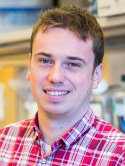Regenerative potential of prostate luminal cells revealed by single-cell analysis Journal Article
| Authors: | Karthaus, W. R.; Hofree, M.; Choi, D.; Linton, E. L.; Turkekul, M.; Bejnood, A.; Carver, B.; Gopalan, A.; Abida, W.; Laudone, V.; Biton, M.; Chaudhary, O.; Xu, T.; Masilionis, I.; Manova, K.; Mazutis, L.; Pe’er, D.; Regev, A.; Sawyers, C. L. |
| Article Title: | Regenerative potential of prostate luminal cells revealed by single-cell analysis |
| Abstract: | Androgen deprivation is the cornerstone of prostate cancer treatment. It results in involution of the normal gland to ~90% of its original size because of the loss of luminal cells. The prostate regenerates when androgen is restored, a process postulated to involve stem cells. Using single-cel RNA sequencing, we identified a rare luminal population in the mouse prostate that expresses stemlike genes (Sca1+ and Psca+) and a large population of differentiated cells (Nkx3.1+, Pbsn+). In organoids and in mice, both populations contribute equally to prostate regeneration, partly through androgen-driven expression of growth factors (Nrg2, Rspo3) by mesenchymal cells acting in a paracrine fashion on luminal cells. Analysis of human prostate tissue revealed similar differentiated and stemlike luminal subpopulations that likewise acquire enhanced regenerative potential after androgen ablation. We propose that prostate regeneration is driven by nearly all persisting luminal cells, not just by rare stem cells. © 2020 American Association for the Advancement of Science. All rights reserved. |
| Keywords: | sequence analysis; genetics; androgen; mouse; animal; metabolism; animals; mice; mus; gene expression; neoplasm proteins; transcription factor; cell differentiation; homeodomain proteins; nerve growth factors; tumor antigen; physiology; transcription factors; prostatic neoplasms; regeneration; rna; prostate; antigens, neoplasm; prostate tumor; tumor protein; androgen antagonists; mesenchymal stem cell; rodent; antiandrogen; homeodomain protein; sequence analysis, rna; organ size; androgens; mesenchymal stem cells; cell; thrombospondin; single cell analysis; single-cell analysis; androgen binding protein; probasin; androgen-binding protein; nerve growth factor; thrombospondins; ataxin 1; gpi-linked proteins; glycosylphosphatidylinositol anchored protein; cancer; humans; human; male; organoids; organoid; atxn1 protein, mouse; nkx3-1 protein, mouse; nrg2 protein, mouse; psca protein, mouse; r-spondin3 protein, mouse; ataxin-1 |
| Journal Title: | Science |
| Volume: | 368 |
| Issue: | 6490 |
| ISSN: | 0036-8075 |
| Publisher: | American Association for the Advancement of Science |
| Date Published: | 2020-05-01 |
| Start Page: | 497 |
| End Page: | 505 |
| Language: | English |
| DOI: | 10.1126/science.aay0267 |
| PUBMED: | 32355025 |
| PROVIDER: | scopus |
| PMCID: | PMC7313621 |
| DOI/URL: | |
| Notes: | Article -- Export Date: 1 June 2020 -- Source: Scopus |
Altmetric
Citation Impact
BMJ Impact Analytics
MSK Authors
Related MSK Work


















